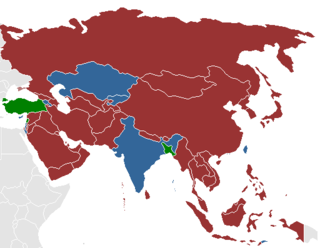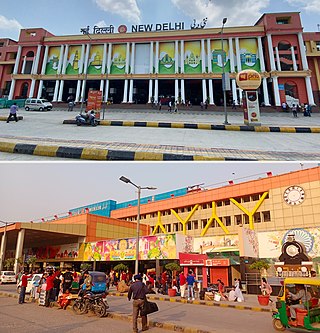
A red-light district or pleasure district is a part of an urban area where a concentration of prostitution and sex-oriented businesses, such as sex shops, strip clubs, and adult theaters, are found. In most cases, red-light districts are particularly associated with female street prostitution, though in some cities, these areas may coincide with spaces of male prostitution and gay venues. Areas in many big cities around the world have acquired an international reputation as red-light districts.

De Wallen is the largest and best known red-light district in Amsterdam. It consists of a network of alleys containing approximately 300 one-room cabins rented by prostitutes who offer their sexual services from behind a window or glass door, typically illuminated with red lights and blacklight. Window prostitution is the most visible and typical kind of red-light district sex work in Amsterdam.
Kamathipura is a neighbourhood in Mumbai, India known for prostitution. It was first settled after 1795 with the construction of causeways that connected the erstwhile seven islands of Mumbai. Initially known as Lal Bazaar, it got its name from the Kamathis (workers) of other areas of the country, who were labourers on construction sites. Due to tough police crackdowns, in the late 1990s with the rise of AIDS and government's redevelopment policy that helped sex workers to move out of the profession and subsequently out of Kamathipura, the number of sex workers in the area has dwindled. In 1992, Brihanmumbai Municipal Corporation (BMC) recorded there were 45,000 sex workers here which was reduced to 1,600 in 2009 and 500 in 2018. Many sex workers have migrated to other areas in Maharashtra with real estate developers taking over the high-priced real estate. In 2018 the Maharashtra government sought tenders to demolish and redevelop the area.
Heera Mandi, is a neighbourhood and bazaar located in the Walled City of Lahore. It is specifically known as the red light district of Lahore, Pakistan.
Sonagachi is a neighbourhood in Kolkata, India, located in North Kolkata near the intersection of Jatindra Mohan Avenue with Beadon Street and Sovabazar, about one kilometer north of the Marble Palace area. Sonagachi is among the largest red-light districts in Asia and the world with several hundred multi-storey brothels residing more than 16,000 commercial sex workers.

Prostitution is legal in India, but a number of related activities including soliciting, kerb crawling, owning or managing a brothel, prostitution in a hotel, child prostitution, pimping and pandering are illegal. There are, however, many brothels illegally operating in Indian cities including Mumbai, Delhi, Kolkata, Pune, and Nagpur, among others. UNAIDS estimate there were 657,829 prostitutes in the country as of 2016. Other unofficial estimates have calculated India has roughly 3 million prostitutes. India is widely regarded as having one of the world's largest commercial sex industry. It has emerged as a global hub of sex tourism, attracting sex tourists from wealthy countries. The sex industry in India is a multi-billion dollar one, and one of the fastest growing.
Sanlaap is an Indian feminist non-governmental organisation, established by Indrani Sinha in 1987 in Calcutta. Based in Calcutta, the group aims to protect the human rights of women and girls. Sanlaap is a developmental organisation that works towards correction of social imbalances which present themselves as gender injustice and violence against women and children. The primary work is focused against trafficking of women and children for commercial sexual exploitation, sexual abuse and forced prostitution. As part of its work, the group starts shops to train girls to make a living and foster their independence.
The All Bengal Women's Union was started in the 1932, when a group of women in West Bengal formed a cadre of like-minded women to help their helpless, exploited and victimized fellow women.
Budhwar Peth is one of many commercial localities in the old city of Pune, India. The area is located in the heart of the city has a high number of electronics shops, and is known for its red-light district. Three out of the five important Ganesh Mandals i.e. Jogeshwari Ganpati, Guruji Talim Mandal, Tulshibaug Ganpati are located here, as is Appa Balwant Chowk, known as ABC.

The Durbar Mahila Samanwaya Committee, or simply Durbar, is a collective of 60,000 sex workers in West Bengal. Established on 15 February 1992, in Sonagachi, the largest red-light district in Kolkata, West Bengal, India with estimated 11,000 sex workers, Durbar has been working on women's rights and sex workers' rights advocacy, anti-human trafficking and HIV/AIDS prevention. The Durbar states that its aims are the challenging and altering of the barriers that form the everyday reality of sex workers' lives as they relate to their poverty or their ostracism. Durbar runs 51 free clinics for sex workers across West Bengal, with support from organisations such as the Ford Foundation and the National AIDS Control Organisation (NACO), who also help Durbar in its initiatives like networking, rights protection and creating alternative livelihood for sex workers.
Prostitution in Kolkata is present in different forms and Kolkata's sex industry is one of the largest in Asia. Prostitution may be brothel-based or non-brothel based as in the case of call girls. India is regarded as having one of the largest commercial sex trades globally. Kolkata has many red-light districts, out of which Sonagachi is the largest red-light district in Asia with more than 50,000 commercial sex workers.

The Gates of Delhi were city gates at various medieval townships around Delhi, built under dynastic rulers in the period that could be dated from the 8th century to the 20th century. They are the gates in:

New Delhi railway station is the main railway station of the Indian capital of New Delhi. Platform 1 is located at Paharganj and platform 16 opens up on to the side of Ajmeri Gate. The station is in Central Delhi, about two kilometres (1.2 mi) north of Connaught Place in New Delhi. It is one of the busiest railway stations in the country in terms of train frequency and passenger movement.
Mayank Austen Soofi is a Delhi-based Indian writer, blogger and photojournalist, who writes popular columns for Hindustan Times and Mint on culture, food and literary landscapes of Delhi.

Nobody Can Love You More: Life in Delhi's Red Light District is a 2012 book by the Indian writer and photojournalist Mayank Austen Soofi.
Geetanjali Babbar is the founder and director of a non-profit named Kat-Katha that works to empower and liberate sex workers in brothels of the largest red light area known as G.B. Road of Delhi.

Naseema Khatoon is an Indian human rights activist hailing from Muzaffarpur, Bihar. She is the founder of Parcham, an NGO that works towards the rehabilitation of sex workers and their families.

Mumbai, is a city in India which contains the neighborhood of Kamathipura, one of the largest red-light districts in Asia. India is regarded as having one of the largest commercial sex trades globally. These neighborhoods are so large and popular that Mumbai has been called the "ultimate destination" for sex tourism. The red-light districts or lal bazaars in Mumbai are inhabited by thousands of sex workers including women, men, children, and transgender people.
Minto Bridge, renamed Shivaji Bridge, is a railway underbridge in New Delhi.










